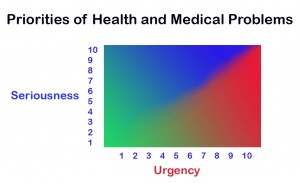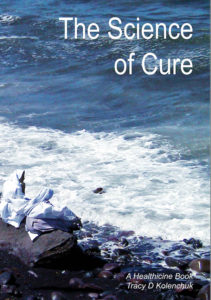 Do you need a medicine, or a healthicine?
Do you need a medicine, or a healthicine?
Are you sick? Or are you suffering from a severe unhealthiness?
Healthicines cure unhealthiness. Medicines cure illness. Symptomicines don’t cure anything – they mask symptoms.
Do you have a medical condition? Is it a health condition, or a sickness? How can you tell? You need to check the priorities. Every medical condition is a problem. Every problem has two dimensions of priorities: urgency and seriousness.
A problem that is very urgent requires immediate attention. A problem that is not urgent, does not require immediate action. If you don’t deal with an urgent problem – it changes into a different problem. For example, you have to pee. Is it urgent? Or can you wait. If it is urgent – and you don’t get to a bathroom soon, you will have a different problem to clean up. In medicine if a problem is urgent, and you don’t address it, you might be dead – a different problem. We rate the urgency of a problem on a scale of 1 to 10. A problem with a score of 1 is not very urgent. You might never need to address it. A problem with a score of 10 is very, very urgent. Note: urgency can rise quickly as time passes, and then it results in a crisis – it goes away, or transforms into another problem. When an urgent problem goes away, you might have a different problem. After a heart attack is treated – your risk of another heart attack rises, becomes more serious.
A problem that is serious requires attention or it will become urgent. It might not be urgent, but because it is serious – it can easily become urgent, in time, if it is not addressed. For example, a very serious depression might not be urgent, but it can lead to a suicide attempt – which has a very high urgency. We rate the seriousness of a problem on a scale from 1 to 10. A problem that is not very serious at all gets a score of 1. It is the type of problem anyone can tolerate, but it might be nice to be rid of it. A problem that is very serious might be causing other damage, and if not addressed will eventually lead to an urgent problem. Note: Seriousness can rise or fall over time.
Every medical condition has an urgency score, and a seriousness score. We can multiply the two scores to get a full priority rating for the condition. If the urgency is low and seriousness is low, the priority is low. If the urgency is high, and the seriousness is high, the priority is high.
Let’s look at some simple examples. Note: These numbers are examples, your results will vary. We are studying the concept, not specific cases.
First, the classic ‘high urgency low seriousness’ problem.
You have to pee. Urgency 8. If you don’t pee soon your body will resolve the issue. Seriousness 3. If you don’t pee soon, you won’t die, although you might feel you died of embarrassment. Priority = 8 * 3 = 24.
Obesity is a serious, but not urgent problem. If you are very, very obese, your urgency score is low, maybe 2 or 3. You don’t need to do anything right now. Tomorrow is another day. Seriousness, on the other hand, is high. If you don’t address the problem, your risk of heart attack, or other medical problems rises. Seriousness 8. Priority = 8 * 3 = 24.
Heart attacks are urgent and serious. You need immediate attention. If you don’t get immediate attention, you might die quickly. Urgency 10, seriousness 10. Priority – 10*10 = 100.
Depression can be serious, but not urgent. If you are very, very depressed, you might withdraw from society. But as long as you don’t contemplate suicide – the urgency is low. Your problem needs to be addressed, but there is time. Urgency 2. Seriousness 8. Priority – 8 * 2 = 16.
Warts are not urgent, and not serious. It might be nice to get rid of them. But if you don’t deal with them, the consequences are minor. And you can always wait until tomorrow. Urgency 1, Seriousness 1. Priority – 1 * 1 = 1. Very low. If it’s somewhere uncomfortable, or very visible, the priority might rise, for example to urgency of 1 and seriousness of 3. Priority – 1 * 3 = 3.
Ok. We’ve got the concept. What has this got to do with healthcines, medicines, and symptomicines?
Medicines Treat Urgent Illnesses
Medicines and medical treatments are designed to address problems with high urgency. If you have a heart attack, or a stroke, or even a broken arm, you need medical attention. Improving your diet or your exercise regimen is not a priority when you have an urgent problem. They might even be dangerous.
Medical problems that have higher urgency have higher need for medicines.
Healthicines treat Illnesses that are Serious, but not Urgent: Uhealthinesses
Healthicines address problems with high seriousness. Serious problems that are not critical, not urgent. Serious problems are caused by severe unhealthiness. Severe unhealthiness can only be addressed by improving healthiness. Healthicines improve healthiness, and cure unhealthinesses. You can’t cure obesity or anorexia with a medicine. The only cure is healthiness, healthy actions, healthicines.
Medical problems that have high seriousness have high need for healthicines. If they have low urgency, they have low need for medicines.
High Priority Problems Need Medicines and Healthicines
Problems that have high urgency and high seriousness need both. Medicines are needed immediately, and healthicines are needed over the long term, if they are to be cured.
Symptomicines are medicines that mask symptoms. They don’t actually address the physical urgency of the problem, although they might address the mental urgency. Some problems have urgency not because they are dangerous, but because they cause significant discomfort, and can be dangerous.
A chronic migraine headache is a problem with low urgency, and in many cases, low seriousness. It is not creating physical danger, and it is not likely to grow into a more serious problem. But it can be very, very painful. Urgency = 3. Seriousness = 3. Priority – 3 * 3 = 9.
A symptomcine reduces the pain and helps the patient to get through the headache.
One advantage of symptomicines is that they give the patient, and the doctor, time to search for a cure. The main danger of symptomicines, is that they can lead to ignoring cures, ignoring the search for a cure, ignoring possibilities for cures.
The other danger of symptomicines is that they create the illusion of a cure, while the illness progresses. If you have an illness with a high seriousness and you are prescribed a symptomicine, the illness continues to get worse, the seriousness continues to get worse and eventually becomes urgent.
If you have high blood pressure, you have a serious health problem. But it is not urgent. The only cures for high blood pressure are activities that improve your healthiness – to health your body with healthy foods and healthy exercise. You can take medicines to lower your blood pressure, creating the illusion of a cure. But the problem continues to progress, to get more serious. The danger of an urgent problem continues to rise.
Chronic Medical Problems
Chronic medical problems are serious, but not urgent. Chronic medical problems are often a result of chronic unhealthy actions. They cannot be cured with medicines, can only be cured with healthiness, with healthicines. Symptomicines are often used to treat chronic medical problems, for two main reasons.
- Symptomicines provide relief to patients and doctors, providing the illusion of a cure.
- Many, perhaps all, chronic medical problems are actually chronic health problems. Chronic health problems can be very, very hard to treat, because the cause of the problem lies in the day to day life of the patient. It is hard to identify what the patient needs to do to address the problem. Even if the changes are known, it is hard to change the patient.
Summary:
Healthicines are things and actions that address unhealthiness and improve healthiness.
Medicines are things and actions that treat illness. Healthicines are often required after to facilitate healing and improvements in health.
Symptomicines address symptoms, but cannot cure and generally do not improve healthiness.
Conclusion:
If we are to gain any ground resolving complex and chronic medical problems, we need to learn more about health, about healthicines.
to your health, tracy
Tracy is the author of two books about healthicine:


